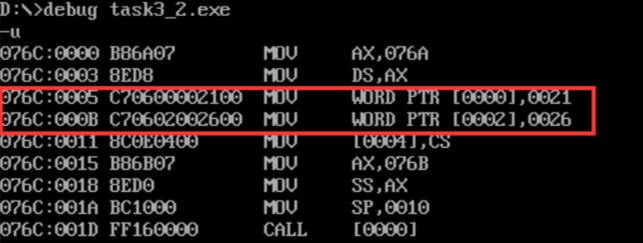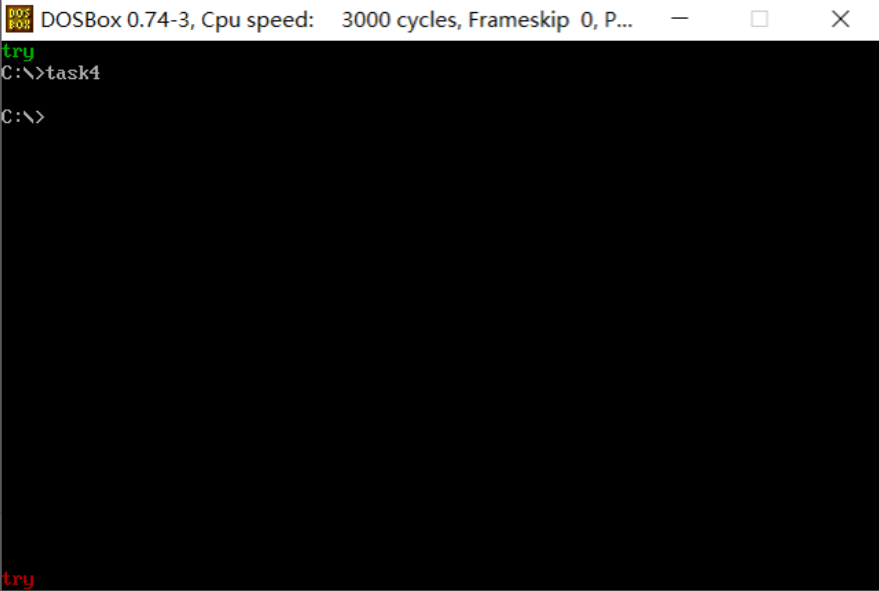实验3 转移指令跳转原理及其简单应用编程
实验任务1
assume cs:code, ds:data data segment x db 1, 9, 3 len1 equ $ - x ; y dw 1, 9, 3 len2 equ $ - y ; data ends code segment start: mov ax, data mov ds, ax mov si, offset x ; mov cx, len1 ; mov ah, 2 s1:mov dl, [si] or dl, 30h int 21h mov dl, ' ' int 21h ; inc si loop s1 mov ah, 2 mov dl, 0ah int 21h ; mov si, offset y ; mov cx, len2/2 ; mov ah, 2 s2:mov dx, [si] or dl, 30h int 21h mov dl, ' ' int 21h ; add si, 2 loop s2 mov ah, 4ch int 21h code ends end start
运行结果:输出两行1 9 3

① line27, 汇编指令 loop s1 跳转时,是根据位移量跳转的。通过debug反汇编,查看其机器码,分析其跳转的位移量是多少?(位移量数值以十进制数值回答)从CPU的角度,说明 是如何计算得到跳转后标号s1其后指令的偏移地址的。

位移量是:14(Loop指令结束地址为:001B,s1指令开始地址为000D,001B-000D=14)
分析:or dl, 30h命令占三个字节,inc指令占一个字节,其他指令各占两个字节,加起来一共14字节。
② line44,汇编指令 loop s2 跳转时,是根据位移量跳转的。通过debug反汇编,查看其机 器码,分析其跳转的位移量是多少?(位移量数值以十进制数值回答)从CPU的角度,说明 是如何计算得到跳转后标号s2其后指令的偏移地址的。

位移量是:16(Loop指令结束地址为:0039,s1指令开始地址为0029,001B-000D=16)
分析:or dl, 30h命令占三个字节,其他指令各占两个字节,加起来一共16字节。
实验任务2
assume cs:code, ds:data
data segment
dw 200h, 0h, 230h, 0h
data ends
stack segment
db 16 dup(0)
stack ends
code segment
start:
mov ax, data
mov ds, ax
mov word ptr ds:[0], offset s1
mov word ptr ds:[2], offset s2
mov ds:[4], cs
mov ax, stack
mov ss, ax
mov sp, 16
call word ptr ds:[0]
s1: pop ax
call dword ptr ds:[2]
s2: pop bx
pop cx
mov ah, 4ch
int 21h
code ends
end start
问题①
根据call指令的跳转原理,先从理论上分析,程序执行到退出(line31)之前,寄存器(ax) = ? 寄存器
(bx) = ? 寄存器(cx) = ?
ax = offset s1,即s1的偏移地址;ax=0021h
bx = offset s2 ,即s2的偏移地址;bx=0026h
cx=cs,即s2的cs值 cx=076C
call指令执行时,会将下一条指令的IP入栈
call word ptr ds:[0],将其下一条指令pop ax的IP入栈,然后跳转。所以pop ax中ax保存的是s1的IP
call dword ptr ds:[0] 将其下一条指令的cs和IP同时入栈,然后进行跳转。所以pop bx中bx保存的是s2的IP,
pop cx中cx保存的是s2的cs值
问题②


实验任务3
assume cs:code, ds:data
data segment
x db 99, 72, 85, 63, 89, 97, 55
len equ $ - x
data ends
code segment
start:
mov ax,data
mov ds,ax
mov byte ptr ds:[len],10
mov cx,7
mov bx,0
s: mov al,ds:[bx]
mov ah,0
inc bx
call printNumber
call printSpace
loop s
mov ah,4ch
int 21h
printNumber:
div byte ptr ds:[len]
mov dx,ax
mov ah,2
or dl,30h
int 21h
mov ah,2
mov dl,dh
or dl,30h
int 21h
ret
printSpace:
mov dl,' '
mov ah,2
int 21h
ret
code ends
end start
运行测试截图


实验任务4
assume cs:code,ds:data
data segment
str db 'try'
len equ $ - str
data ends
code segment
start:
mov ax, data
mov ds, ax
mov bl, 2
mov bh, 0
call printStr
mov bl, 4
mov bh, 24
call printStr
mov ax, 4c00h
int 21h
printStr:
mov ax, 0b800h
mov es, ax
mov si, offset str
mov cx, len
mov al,0A0h
mul bh
mov di, ax
s: mov al,[si]
mov es:[di], al
mov es:[di+1], bl
inc si
add di, 2
loop s
ret
code ends
end start
运行测试截图:

实验任务5
assume ds:data, cs:code
data segment
stu_no db '201983290260'
len = $ - stu_no
data ends
code segment
start:
mov ax, data
mov ds, ax
mov cx, 4000
mov si, offset stu_no
mov ax, 0b800h
mov es, ax
mov di, 0
mov ah,17h
s: mov al, 0
mov es:[di], al
mov es:[di+1], ah
inc si
add di, 2
loop s
mov di, 3840
mov si, offset stu_no
mov cx, 74
mov ah, 17h
s1: call printgang
add di, 2
loop s1
mov di, 3908
mov si, offset stu_no
mov cx, len
mov ah, 17h
s2: call printStu_no
inc si
add di, 2
loop s2
mov di, 3932
mov si, offset stu_no
mov cx, 74
mov ah, 17h
s3: call printgang
add di, 2
loop s3
mov ax, 4c00h
int 21h
printStu_no:mov al, [si]
mov es:[di], al
mov es:[di+1], ah
ret
printgang:mov al, 45
mov es:[di], al
mov es:[di + 1], ah
ret
code ends
end start
运行结果截图:





